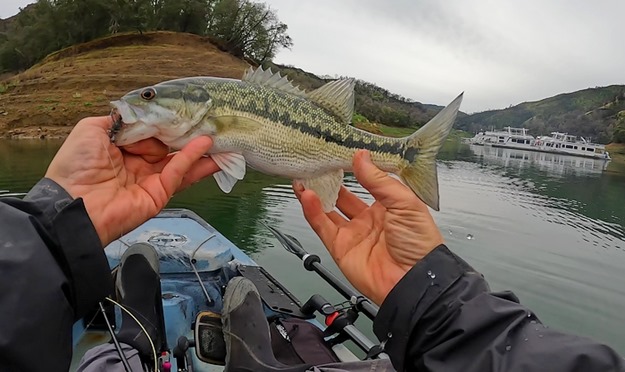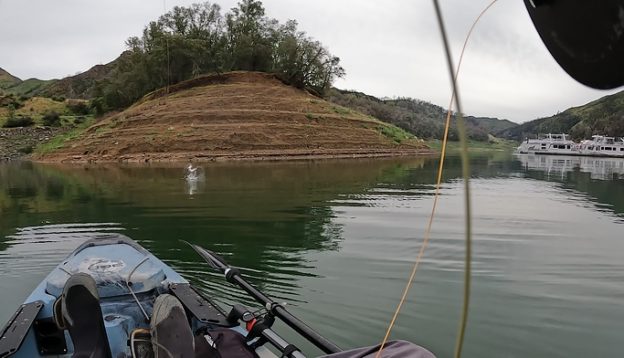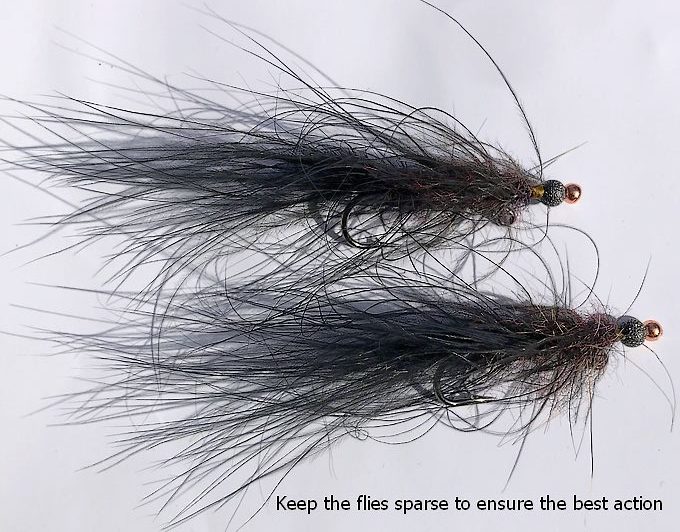It’s an excuse to fiddle mostly … the discovery of something new that you’ve never tried stimulates both optimism and creativity. The normal guardrails that exist when being shown something vanish when it’s a chance encounter; something read, something seen, or something accidentally observed.
This week I was fiddling with “balanced leeches”, and after viewing several videos, numerous fly patterns and articles describing the style and theory behind the practice – it sounded like great fun. A large Bobber-cator suspends a leech pattern in the water – with beads tied forward of the eye to “balance” the fly in a horizontal attitude, versus hanging from the indicator perpendicularly.
In theory, the wave and wind action would then make the fly dance fetchingly on the end of its tether, compelling even the most wary fish to scarf it down.
While it was fun staring at the strike indicator waiting for it to disappear, the theory and the practice proved much different. I hooked and landed three fish but each ate the leech after I moved the indicator with a short strip. I tried diligently but the wave action induced dance failed to yield a fish strike – but mitigating circumstances might have altered the result.
I was fishing the deep end of the lake – which is less conducive to flies fished close to the surface. I opted to fish the fly about 3.5 feet from the indicator to give it some sinking ability – but I was attending a local club’s Berryessa outing and launched where the club intended, versus launching where shoreline and depth aided this style. While the club promptly roared away towards parts unseen (likely shallower), I was left in the “knife cut” portion of the lake where the canyon near the dam makes the depth drop away abruptly.
I moved out of the creek arm and into the open portion of the lake where waves and gusty wind made the action on the fly much more vigorous. I focused on the points and drop-offs that were visible close to shore and managed a few grabs as well as a brace of spotted bass.

Water temperature was about 62 degrees, which is on the chill side but not excessively so, and might have made fish less willing to chase or swim up from the depths below.
I encountered a few fish chasing minnows in an after bay and managed to land one of them. These fish had proven (in earlier trips) difficult to catch as they move about with great speed chasing the bait swarm. With the balanced leech technique you can leave the fly stationary until the feeding fish return to where it was cast, then give it a twitch to induce a take.
In simple sight testing the fly, observing wave action on the suspended bait, the sparser dressed flies were much more animated and “swam” better. Large clumps of marabou do not respond to the gentle motion of wave and wind and tend to simply “bob” up and down. Traditional leech flies, with the wing (tail) tied sparsely – swam quite nicely when the indicator was disturbed.
I used enough marabou to give good silhouette but not enough to make the fly opaque. The overall flue length was chosen to position the hook in the center of the fly, offering ample movement of the tail and palmered hackle, but not so long as to induce the short strike, where the fish misses the hook entirely. The double bead offers a chance for a “rattle” when yanked – and is something I am fiddling with to add sound to my bass flies.
As the weather warms I’ll move to the shallower sections of the lake to fish over the emergent weed beds. Numerous weed “shoals” exist on the east side of the lake that harbor a lot of fish during summer months. I’m thinking this method will give me the opportunity to fish within the clumps – as well as suspend a fly above the weeds indefinitely .. offering a couple options I’ve not had before.
I did manage to bend a few of the dressmaker pins used to support the beads. They will deform on the occasional snag – as well as yanked through wooden snags or similar underwater obstacles. I simply bent the pins back into their original shape with finger pressure. I could see some flies having more issue with pin deformity – but only if fly components were attached directly to the pin instead of the shank. As my flies were simplistic in design, akin to Wooly Bugger flies, I had no issue with the pins and fly construction.



Good looking fish – tell me about your boat.
https://www.hobie.com/kayaks/mirage-pro-angler-12-360/
It’s a Hobie ProAngler 360 12′ battleship. Designed for fishing instead of simply going places, it’s heavy as lead, has storage for rods and tackle, and a wonderful seat (above water) that allows the angler to think he’s Cleopatra on her royal barge. It was my retirement gift to myself … and worth every cent (of its outlandish price).
In drought conditions it’s a heavy SOB – especially when dragging it several hundred yards up a shale slope to the parking area, 105 pounds empty, add lunch, drinks, tackle, anchors, and all the other creature comforts and you’ll wish for a brace of draft horses to assist.
I will be writing some articles shortly on its configuration. There are some significant issues that folks new to kayaks will be facing, and after three years of fiddling with how it’s equipped, I’d like to share some features and myths that may help folks determine what’s really needed for their angling.